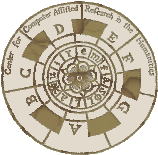CCARH Publications
42 Ojibway Songs, encoded by Paul
von Hippel, 1998. 
CCARH Publications
42 Ojibway Songs, encoded by Paul
von Hippel, 1998. |
 |
 Individual songs
Individual songs Zipped collection
Zipped collection Catalog of notated themes
Catalog of notated themesThese melodies were sampled at random from Frances Densmore's (1909, 1912) two volumes of music by the Ojibway Indians of northern Minnesota. The random sample included only songs that were fully transcribed in common music notation -- not, that is, those songs represented only by an Ojibway "song picture" or by one of Densmore's analytic sketches.
All of the melodies use the **kern format and so can be analyzed using David Huron's Humdrum Toolkit software for music analysis (www.humdrum.org). Besides the standard Humdrum reference records, these transcriptions include records beginning "!!!PPG" to indicate the page number on which Densmore's transcription originally appeared.
In addition to the standard **kern signifiers, the following signifiers are adapted from Densmore's transcriptions:
| > | indicates that the note is sung less than a semitone above the notated pitch |
| < | indicates that the note is sung less than a semitone below the notated pitch |
Scholars using these transcriptions for research purposes should cite the database as follows:
von Hippel, Paul (Ed.). (1998) 42 Ojibway songs in the Humdrum **kern representation: Electronic transcriptions from the Densmore collections [computer database]. Center for Computer Assisted Research in the Humanities, Stanford, CA (www.ccarh.org/publications/data/humdrum/ojibway).
Densmore, F. (1909) Chippewa [i.e., Ojibway] Music, Bulletin 45 of the Bureau of American Ethnology, Smithsonian Institution. Washington, D.C.: Government Printing Office. Densmore, F. (1912) Chippewa [i.e., Ojibway] Music--II, Bulletin 53 of the Bureau of American Ethnology, Smithsonian Institution. Washington, D.C.: Government Printing Office. Huron, D. (1988) Error categories, detection, and reduction in a musical database. Computers and the Humanities 22: 253-264.